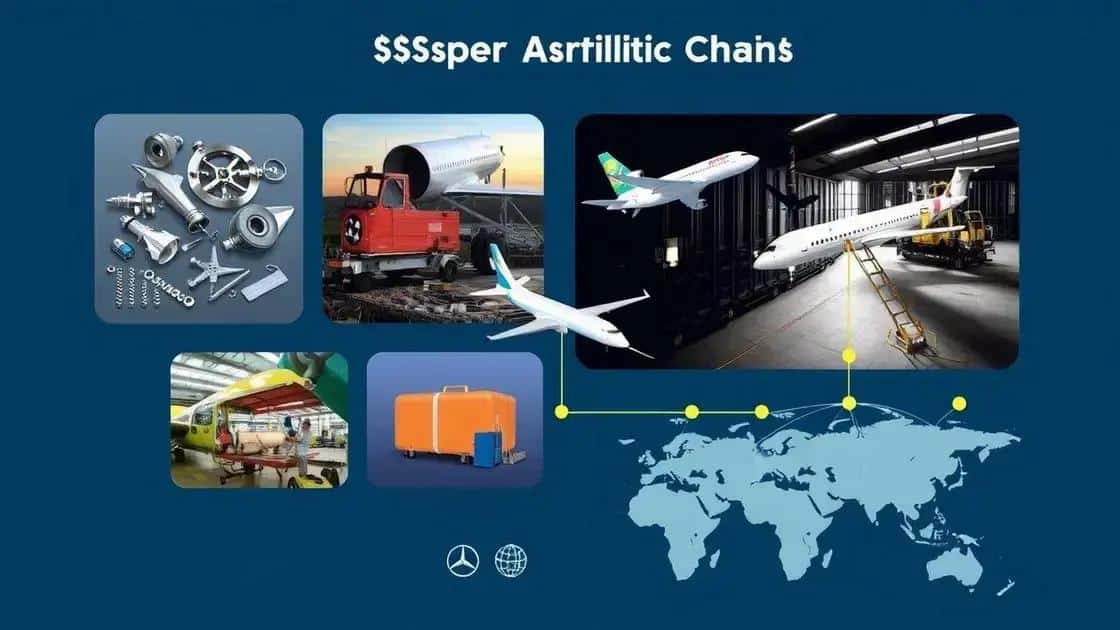Boeing Airbus supply chain issues: are we prepared?
Anúncios
Boeing and Airbus are currently facing significant supply chain issues driven by component shortages, labor challenges, and geopolitical tensions, which disrupt production and delivery schedules.
Boeing Airbus supply chain issues are making headlines lately, raising questions about their impact on the aviation sector. But what does this mean for travelers and stakeholders alike? Let’s dive into the complexities of this situation.
Understanding the current supply chain landscape
In today’s fast-paced aviation industry, understanding the current supply chain landscape is crucial for both manufacturers and consumers. With the global marketplace interconnected, any disruption can lead to significant delays and challenges.
Current State of the Supply Chain
The supply chain for Boeing and Airbus is experiencing various strains that affect their production processes. These challenges arise from multiple factors such as shortages of essential components, labor issues, and geopolitical tensions.
One key aspect is the reliance on a network of suppliers. When one supplier faces difficulties, it can create a ripple effect throughout the entire system. For instance, raw material shortages can limit the production capacity of parts, causing delays in aircraft manufacturing.
Factors Influencing Supply Chain Issues
- ⚙️ Component Shortages: Many aircraft manufacturers depend on specialized parts, often sourced from different countries. Any disruption can halt production.
- 👷 Labor Challenges: The pandemic has created significant workforce shortages, impacting production timelines.
- 🌍 Geopolitical Factors: Trade tensions and conflicts can restrict the flow of critical materials and components.
- 🚀 Technological Advancements: A shift towards newer technologies can sometimes outpace existing supply capabilities, leading to mismatches.
Moreover, environmental regulations are becoming increasingly stringent, forcing manufacturers to adapt quickly. This can mean re-evaluating current supplier relationships or even changing production strategies to meet compliance requirements. Every aspect of the supply chain, from raw materials to final assembly, must be cohesive and well-managed.
As these factors evolve, companies must remain agile. Developing contingency plans and diversifying their supply sources can empower them to mitigate risks effectively. Being proactive rather than reactive can make a significant difference in overcoming challenges.
With all these dynamics at play, it’s more important than ever for stakeholders in the aviation sector to keep a close eye on supply chain developments. Understanding how the landscape shifts will aid in making informed decisions.
Key factors affecting Boeing and Airbus supply chains

Various key factors affecting Boeing and Airbus supply chains play a significant role in the aviation industry. Understanding these factors helps businesses and consumers alike to anticipate changes and challenges.
Component Sourcing Challenges
Both Boeing and Airbus rely on a complex web of suppliers for specialized parts. Any delay from a single supplier can disrupt production timelines. For instance, if an essential component is not available, it can lead to significant delays.
- Global Dependency: The supply chains extend across the globe, making them sensitive to international events.
- Material Shortages: A shortage of materials like metals and plastics can halt manufacturing processes.
- Geopolitical Issues: Political tensions and trade disputes can restrict access to necessary parts and materials.
As suppliers face their own challenges, the ripple effects are felt throughout the supply chain. Disruptions can lead to increased costs and extended delivery times for new aircraft, which directly impacts airlines and customers.
Labor Market Dynamics
The aviation industry is also facing labor shortages, which significantly affect production capabilities. Many skilled workers left the industry during the pandemic, and attracting them back has been a challenge.
As companies strive to ramp up production, they must also deal with the increased costs of labor. This situation can lead to longer hiring processes and potential delays in aircraft deliveries. It’s crucial for manufacturers to create appealing work environments to attract talent back into the sector.
Moreover, training programs are necessary to ensure new employees possess the skills needed to keep production on track. Efficiently addressing these labor issues is vital for the future of both Boeing and Airbus.
Technological Advancements
Technological advancements are another critical factor. While they can improve efficiency and reduce costs, implementing new technologies can also create challenges. Both companies must navigate the balance of integrating new systems while maintaining their existing operations.
Staying ahead in the competitive aviation market often requires investment in newer technologies for assembly and manufacturing processes. Quick adoption can pose risks, especially if suppliers are not ready to support these changes.
Understanding these key factors affecting the supply chain allows Airlines and manufacturers to strategize effectively. By recognizing how these challenges interplay, they can develop tailored solutions to ensure operational continuity.
How supply chain issues impact aircraft production
Supply chain issues have a profound effect on how aircraft production operates. In particular, delays and disruptions can significantly impact timelines and costs, which leads to broader consequences for airlines and manufacturers alike.
Delays in Production Timelines
When key components are delayed, it sets off a chain reaction. For example, manufacturers like Boeing and Airbus depend on timely delivery of engines and avionics. If there’s a setback in receiving these parts, production schedules are adversely affected.
- Extended Delivery Times: Aircraft may take longer to build and deliver due to missing parts.
- Increased Costs: Delays can lead to higher operational costs as labor and resource allocation changes.
- Strained Relationships: Problems with suppliers can weaken trust and reliability, complicating future collaborative efforts.
Hence, a smooth-running supply chain is critical for efficient production. When disruptions occur, they also lead to increased waiting periods for airlines eager to start using new aircraft.
Quality Control Issues
Additionally, supply chain disruptions can create quality control concerns. When production must be rushed to make up for lost time, there may be compromises on testing and quality assurance protocols.
If manufacturers push parts to production without thorough checks, it risks future operational safety issues. This not only impacts airlines but can also lead to costly recalls and repairs.
Moreover, inconsistent parts from suppliers can vary in quality, which complicates assembly and maintenance. As a result, a chain of quality concerns can emerge from merely one supply chain issue.
Impact on Financial Stability
Lastly, the financial ramifications of supply chain issues can be severe. For aircraft manufacturers, delays often mean a cascade of financial challenges.
- 💸 Lost Revenue: Airlines may delay or cancel orders when production timelines stretch.
- 📉 Stock Prices: Uncertainty around production capabilities can impact investor confidence and stock market performance.
- 🧾 Operational Costs: Increased costs from delays may lead to budget overruns that affect future projects.
Understanding how these supply chain issues impact aircraft production is essential for stakeholders to prepare strategically. By recognizing challenges and proactively addressing them, manufacturers can work towards stability and resilience in their operations.
Strategies for mitigating supply chain challenges

Mitigating supply chain challenges requires strategic thinking and proactive measures. Companies like Boeing and Airbus need to be prepared for disruptions and find ways to keep their operations running smoothly.
Diversifying Suppliers
One effective strategy is to diversify suppliers. By not relying on a single source for critical components, manufacturers can buffer themselves against disruptions. This approach helps to ensure that if one supplier faces challenges, others can step in to fill the gaps.
- Multiple Locations: Use suppliers from different regions to reduce risks from geopolitical tensions.
- Approved Supplier Lists: Maintain a list of backup suppliers who meet quality specifications.
- Flexible Contracts: Create adaptable contracts that allow for adjustments in demand.
This flexibility can enhance resilience, allowing businesses to respond quickly when issues arise.
Investing in Technology
Investing in technology also plays a crucial role in overcoming supply chain challenges. Technologies like artificial intelligence (AI) and big data analytics can enhance logistics and tracking.
With data analytics, companies can better predict potential disruptions and optimize their inventory levels accordingly. This proactive approach minimizes the impact of potential shortages or delays.
Additionally, automation can streamline processes, making production more efficient. By reducing reliance on manual labor, companies can better manage labor shortages during crises.
Building Strong Relationships
Another important strategy is to build strong relationships with suppliers. Open communication is vital for identifying issues early and developing joint solutions.
Regular meetings and progress updates can foster a sense of partnership. By working closely with suppliers, manufacturers can enhance understanding and cooperation.
Collaborative planning allows businesses to align expectations and prepare for demand changes together. Strong relationships can lead to better service and faster recovery from disturbances in the supply chain.
Maintaining Inventory Buffers
It’s beneficial to maintain inventory buffers for critical parts. This can prove to be a lifesaver during sudden disruptions.
- Safety Stock: Keep additional stock on hand to cover unexpected demand or supply delays.
- Just-in-Case vs. Just-in-Time: Adjust between just-in-time and just-in-case inventory strategies to find a balance that suits your organization.
- Continuous Review: Regularly assess inventory levels to ensure that you have the right amount of stock on hand.
By implementing these strategies, companies can better navigate the complexities of the aviation supply chain. With resilience and adaptability, they can address challenges and continue to thrive amidst uncertainties.
FAQ – Frequently Asked Questions about Boeing and Airbus Supply Chain Issues
What are the main challenges Boeing and Airbus face in their supply chains?
The main challenges include component shortages, labor issues, and geopolitical tensions that disrupt production schedules.
How can companies mitigate supply chain disruptions?
Companies can diversify suppliers, invest in technology, build strong relationships, and maintain inventory buffers to reduce risks.
What role does technology play in managing supply chains?
Technology helps enhance tracking, optimize inventory levels, and improve overall efficiency in supply chain operations.
Why is maintaining strong supplier relationships important?
Strong relationships with suppliers enable better communication and collaboration, allowing for quick solutions to potential disruptions.






